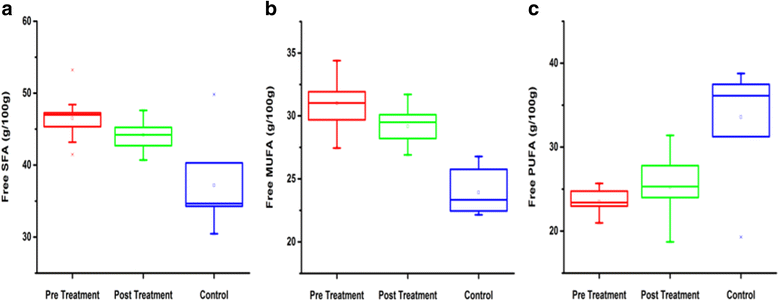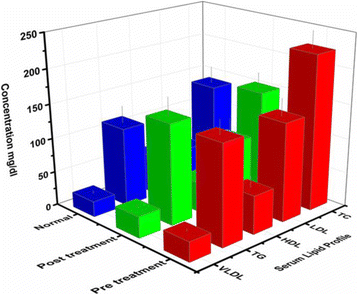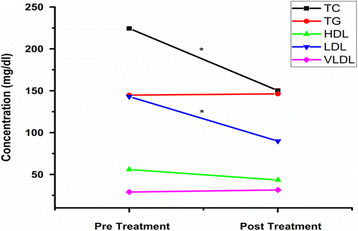Radiotherapy improves serum fatty acids and lipid profile in breast cancer
- PMID: 28521812
- PMCID: PMC5437547
- DOI: 10.1186/s12944-017-0481-y
Radiotherapy improves serum fatty acids and lipid profile in breast cancer
Abstract
Background: Breast cancer is a disease with diverse clinical symptoms, molecular profiles, and its nature to response its therapeutic treatments. Radiotherapy (RT), along with surgery and chemotherapy is a part of treatment in breast cancer. The aim of present study was to investigate pre and post treatment effects of radiotherapy in serum fatty acids and its lipids profile in patients with breast cancer.
Methods: In this comparative as well as follow up study, Serum fatty acids were performed by gas chromatography to investigate fatty acids and Microlab for analysis of lipid profile.
Results: Among serum free and total fatty acids the major saturated fatty acids (SFAs) in serum lipids of breast cancer patients (pre and post treated) were stearic acid (18:0) and palmitic acid (16:0). These fatty acids contributed about 35-50% of total fatty acids. The decreased concentrations of linoleic acid (C18:2) and arachidonic acid (C20:4) with a lower ratio of C18:2/C18:1 was found in pretreated breast cancer patients as compared to controls. The n-3/n-6 ratio of breast cancer patients was decreased before treatment but it was 35% increased after treatment. In addition, plasma activity of D6 desaturase was increased in the breast cancer patients, while the activity of D5 desaturase was decreased. Increased levels of SFAs, monounsaturated fatty acids (MUFAs) and decreased polyunsaturated fatty acids (PUFAs) levels in breast cancer patients (pre and post treated) as compared to controls. Serum total cholesterol (TC) (224.4 mg/dL) and low density lipoprotein cholesterol (LDL-C) (142.9 mg/dL) were significantly increased in pretreated breast cancer patients but after the radiotherapy treatment, the TC (150.2 mg/dL) and LDL-C (89.8 mg/dL) were decreased.
Conclusion: It seems that RT would have played a potential role in the treatment of BC. After RT the serum levels of PUFAs, TC, and LDL-C are improved. Our study reinforces the important role of RT in the management of BC. The level of PUFAs, TC, and LDL-C can be used as the biomarkers for early diagnosis in individuals with risk of breast cancer.
Keywords: Breast cancer; Fatty acids; Gas chromatography; Lipids; Radiotherapy.
Figures




Similar articles
-
Serum fatty acids and risk of breast cancer in a nested case-control study of the New York University Women's Health Study.Cancer Epidemiol Biomarkers Prev. 2002 Nov;11(11):1353-60. Cancer Epidemiol Biomarkers Prev. 2002. PMID: 12433711 Clinical Trial.
-
Prospective associations between plasma saturated, monounsaturated and polyunsaturated fatty acids and overall and breast cancer risk - modulation by antioxidants: a nested case-control study.PLoS One. 2014 Feb 27;9(2):e90442. doi: 10.1371/journal.pone.0090442. eCollection 2014. PLoS One. 2014. PMID: 24587366 Free PMC article.
-
The association of desaturase 9 and plasma fatty acid composition with insulin resistance-associated factors in female adolescents.Metabolism. 2009 Feb;58(2):158-66. doi: 10.1016/j.metabol.2008.09.008. Metabolism. 2009. PMID: 19154947
-
Role of fatty acids in malignancy and visual impairment: epidemiological evidence and experimental studies.Histol Histopathol. 2009 Feb;24(2):223-34. doi: 10.14670/HH-24.223. Histol Histopathol. 2009. PMID: 19085838 Review.
-
Emerging roles of low-density lipoprotein in the development and treatment of breast cancer.Lipids Health Dis. 2019 Jun 10;18(1):137. doi: 10.1186/s12944-019-1075-7. Lipids Health Dis. 2019. PMID: 31182104 Free PMC article. Review.
Cited by
-
Targeting Long Chain Acyl-CoA Synthetases for Cancer Therapy.Int J Mol Sci. 2019 Jul 24;20(15):3624. doi: 10.3390/ijms20153624. Int J Mol Sci. 2019. PMID: 31344914 Free PMC article. Review.
-
Longitudinal Changes in the Fatty Acid Profile in Patients with Head and Neck Cancer: Associations with Treatment and Inflammatory Response.Cancers (Basel). 2022 Jul 29;14(15):3696. doi: 10.3390/cancers14153696. Cancers (Basel). 2022. PMID: 35954360 Free PMC article.
-
Longitudinal Changes in Circulating Metabolites and Lipoproteins After Breast Cancer Treatment.Front Oncol. 2022 Jun 16;12:919522. doi: 10.3389/fonc.2022.919522. eCollection 2022. Front Oncol. 2022. PMID: 35785197 Free PMC article.
-
Plasma free fatty acid levels in cervical cancer: concurrent chemoradiotherapy improves abnormal profile.Front Pharmacol. 2024 Feb 21;15:1352101. doi: 10.3389/fphar.2024.1352101. eCollection 2024. Front Pharmacol. 2024. PMID: 38449803 Free PMC article.
-
The Predictive Role of Serum Lipid Levels, p53 and ki-67, According to Molecular Subtypes in Breast Cancer: A Randomized Clinical Study.Int J Mol Sci. 2024 Mar 31;25(7):3911. doi: 10.3390/ijms25073911. Int J Mol Sci. 2024. PMID: 38612725 Free PMC article. Clinical Trial.
References
MeSH terms
Substances
LinkOut - more resources
Full Text Sources
Other Literature Sources
Medical

